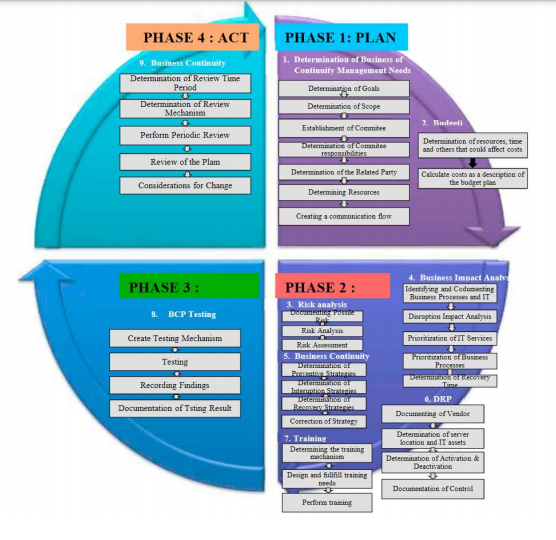Does my company need a business continuity plan? What's the worst thing that can happen?
In the words of Murphy's Law, 'Anything that can go wrong, will go wrong.'
Today we live in a world where our life runs 24*7 and so does our businesses. We all live in a global world where there are trillions of customers base and we all try to run our business on a continuous 24*7*365 reach basis. But is it practically feasible to run our businesses these days without facing disruptions maybe natural, man-made, pandemic and various other reasons.
Businesses these days face an unprecedented number of exposures. The frequency and severity of weather-related events, Global pandemic, natural disasters, cyber attacks seem to be increasing and reliance on a complex network of technology and supply chains is expanding. Both trends leave businesses susceptible to a variety of existing and emerging risks. Managing these risks by developing a business continuity strategy is key to the survival of any organization.

So what is Business Continuity?
Business continuity is an organization's ability to maintain essential functions during and after a disaster has occurred. Business continuity planning establishes risk management processes and procedures that aim to prevent interruptions to mission-critical services and re-establish full function to the organization as quickly and smoothly as possible.
The most basic business continuity requirement is to keep essential functions up and running during a disaster and to recover with as little downtime as possible. A business continuity plan considers various unpredictable events, such as natural disasters, fires, disease outbreaks, cyberattacks and other external threats.
Business continuity is important for organizations of any size, but it might not be practical for any but the largest enterprises to maintain all functions for the duration of a disaster. According to many experts, the first step in business continuity planning is deciding what functions are essential and allocating the available budget accordingly. Once crucial components have been identified, administrators can put failover mechanisms in place.
Technologies such as disk mirroring enable an organization to maintain up-to-date copies of data in geographically dispersed locations, not just in the primary data center. This enables data access to continue uninterrupted if one location is disabled and protects against data loss.
What is a Business Continuity Plan?
A Business Continuity Plan (BCP) is a document that defines the how a business will continue after/during an unplanned disruption in services. It is more detailed and well-structured than a Disaster Recovery Plan and contains backups for business process, Critical Information Assets, Assets, and Human Resources i.e. any and every aspect due to which business can be affected/impacted.
A BCP usually contains a detailed checklist which includes supplies and management, data backups, server availabilities, an off-site arrangement facilities etc. A BCP also contains BCP Administrators and Emergency Contact numbers and info of the resource persons and information of other various key aspects. A BCP can also contain detailed strategies on how business operations can be managed on short term as well as long term outages.
A key component of a business continuity plan (BCP) is a disaster recovery plan that contains strategies for handling IT disruptions to networks, servers, personal computers, mobile devices etc. The plan should cover how to reestablish office productivity and enterprise software so that key business needs can be met. Manual workarounds should be outlined in the plan, so operations can continue until computer systems can be restored.
There are three primary aspects to a business continuity plan for key applications and processes:
- High availability: Provide for the capability and processes so that a business has access to applications regardless of local failures. These failures might be in the business processes, in the physical facilities or in the IT hardware or software.
- Continuous operations: Safeguard the ability to keep things running during a disruption, as well as during planned outages such as scheduled backups or planned maintenance.
- Disaster recovery: Establish a way to recover a data center at a different site if a disaster destroys the primary site or otherwise renders it inoperable.
Why is Business Continuity Planning Important?
A Business Continuity Plan is essential for every business organization these days. Lack of planning and careless assessment can lead to huge financial losses, Human Resources losses, can impact business reputation, goodwill, brand image and even result in loss of consumer base.
To withstand and thrive during these many threats, businesses have realized that they need to do more than create a reliable infrastructure that supports growth and protects data. Companies are now developing holistic business continuity plans that can keep your business up and running, protect data, safeguard the brand, retain customers - and ultimately help reduce total operating costs over the long term. Having a business continuity plan in place can minimize downtime and achieve sustainable improvements in business continuity, IT disaster recovery, corporate crisis management capabilities and regulatory compliance.
Yet developing a comprehensive business continuity plan has become more difficult because systems are increasingly integrated and distributed across hybrid IT environments - creating potential vulnerabilities. Linking more critical systems together to manage higher expectations complicates business continuity planning - along with disaster recovery, resiliency, regulatory compliance and security. When one link in the chain breaks or comes under attack, the impact can ripple throughout the business. An organization can face revenue loss and eroded customer trust if it fails to maintain business resiliency while rapidly adapting and responding to risks and opportunities.
BCP is all about running business even at the time of unplanned disruption by resuming the most critical activities on priority basis and assuring stability in overall business management. It further helps reduce financial loss and ensure the business stays afloat even during the crisis.
Common misconceptions
When it comes to business continuity, there are many common misconceptions. These misconceptions are what most companies use as excuses for not having a business continuity plan.
Insurance covers losses
Yes, insurance does cover losses but excludes events such as death, federal violations, and loss of reputation. In some instances, business owners incorporate public liability insurance within their contingency plans for added security. It proves to be useful when a company handles clients and customers; having a business continuity plan can help a business owner mitigate those risks.
We know what to do in an emergency
Realistically, an outline of an emergency response plan is helpful, yet it won't provide you with much guidance on what to do when your building has been affected by a tornado or flooding.
When an emergency strikes, emotions are running high. At that moment, it's difficult to help everyone stay calm. A pre-defined plan can assist in handling an emergency in a calm and collected manner.
I don't have time to develop a BC plan
Creating a business continuity plan is a time-consuming task that requires a lot of expertise and knowledge. However, it's worth the time, money, and effort put into it. Backed by 30 years' experience, Agility Recovery helps protect companies from an unexpected and extends a hand to those that are in need.
Apart from innocuous misconceptions, there are substantial risks that stand behind the lack of business continuity and disaster recovery plan.
1. Violations
Every business, with only a few exceptions, is required to have an Emergency Action Plan (EAP). At any time, your company can be surprised by a random audit. Failure to comply with the minimum requirements will result in a violation and a hefty fine.
2. Reputation
Even large organizations, such as Facebook, whose primary product is communication, can mishandle a crisis. Your clients may be able to accept the fact that the accident happened, but they also expect your business to quickly respond to any disruption, no matter the extent. The way that a company responds to a crisis can make or break its reputation for many years to come
3. Injury or death
Regardless of the type of accident, the main goal of any company is to keep the employees and customers safe. Companies that lack comprehensive business continuity plans will find this task more challenging. To prevent injury or death, stepping away from the handwritten EAP's and getting on board with the new business continuity technology is a good investment.
4. Financial risk
Financial loss may be among other consequences of a lack of a business continuity plan. The cost of business interruption varies from $5.8 million due to fire or explosion, $4.4 million due to a storm, or $0.55 million due to water damages†. The longer the downtime is, the higher the losses. Having a business continuity plan that covers all bases can help reduce downtime and improve RTO. Depending on the severity of the situation, your company may also be liable, which could end up costing you even more. Having a business continuity plan is like having sleep insurance.
Some of the Key Elements of a Business Continuity Plan
1. Establish a Planning Committee
Depending on the size of your practice, the emergency planning team may include veterinarians, practice managers, and supervisors. The committee at smaller practices may include all employees.
2. Conduct a Business Impact Analysis
A business impact analysis (BIA) supports the entire business continuity process. It is a process used to identify, quantify, and qualify the impact of a loss, interruption, or disruption. A BIA identifies mission-critical activities and the time frame within which they must be recovered. Explore all the risks that your practice is exposed to and the possible major disruptions that could occur.
And don't forget about your suppliers. Could you still operate if your top vendors closed due to a disaster? Consider the actions needed for your practice to remain operational. Plan alternatives for your critical supplier dependencies.
3. Mitigate Risk
After the BIA, the practice should mitigate risks that threaten the health and safety of people, operations, patients, company assets, or the environment by reducing the risk to an acceptable level. Strategies may include:
- Building construction
- Security and fire protection systems
- Minimizing or eliminating single points of dependency
- Vendor readiness and qualification of secondary suppliers
- IT backup strategies and direct response sites
- Pre-purchasing of critical equipment or components for repair
- Splitting critical functions and resources between multiple sites
- Substitution of less hazardous components
- Preventative maintenance and testing programs
- Cross-training of personnel
4. Establish Business Continuity Strategies
Establish strategies for:
- Alternate practices to work at temporarily
- Mutual aid agreements with animal shelters or other veterinary practices to take patients
- Cross-training
- Outsourcing
- Use of secondary suppliers
- Prioritization of customers who need care for their pets
- Referring customers to a pre-identified alternate practice
- Work-at-home strategies
- Mobile offices
- Manual and alternate procedures if computer systems are down
5. Develop Your Plan
Record everything in the BIA process and develop a plan for disasters and emergencies. At a minimum, the plan should include:
- Policy, purpose, and scope
- Goals and objectives
- Assumptions
- Key roles and responsibilities
- Business impact analysis (BIA) results
- Risk mitigation plans
- Offsite data and storage requirements
- Business recovery and continuity strategies
- Alternate operating strategies
- Supplier vendor readiness
- Plan activation and universal response
- Communication and notification plan
- Training, drills, and exercises
- Plan maintenance
Add materials to the plan appendix including:
- Important contacts (internal and external)
- Initial notification form
- Action logs and issues tracking forms
- Damage assessment form
- Status forms (personnel, facility, operations)
- Site emergency procedures
- Site plans and asset lists
- Supplier and vendor response plan
- Client response plan
- Critical business functions
- Detailed alternate operating and recovery strategies
- Equipment recovery priority
6. Communication & Implementation
Conduct training for employees with key roles and assignments in the business continuity, disaster recovery, and incident response processes. Clear communication is vital during business disruptions. Effective communication across your business can reassure team members and give them confidence that the organization is taking effective steps to respond and recover. Outside of your company, good communication is also necessary in order to liaise with suppliers and customers and minimize dissatisfaction.
To prepare for this, a business continuity plan will normally include a list of key contacts as well as templated press releases and social media posts. Having these in place in advance can speed up communication in a crisis and ensure that both your staff and external contacts are kept up to speed. In larger organizations, it may be necessary to have a separate communication plan that provides a comprehensive approach to communication during a crisis.
7. Test the Plan & Training
Business continuity plans are not just theoretical - they need to be robust enough to be put into action. In order to check this, the final key component of a business continuity plan is testing and exercising.
Realistic scenarios can be used to test the plan and your team's response. By doing so, you can identify room for improvement and take action to improve the plan before a disruption occurs. Testing and exercising business continuity plans also helps to ensure that key personnel understand the plan and their role in it. This means that the company can respond quickly and efficiently when a disruption occurs.
Raising awareness of the business continuity plan among your wider staff will also help them to understand their role in responding to disruptions. Many companies run regular awareness training sessions and include business continuity as a key topic during new staff inductions. This training can then improve the resilience of the company overall.
Summary
In conclusion, use these basic elements of emergency planning to prioritize key business processes, identify significant threats to normal operations, and plan mitigation strategies. A business continuity plan is an essential element for every veterinary practice.
Conclusion
Preparing a Business Continuity Plan (BCP) is important for the organization. The business continuity plan allows an organization to plan its business continuity for the long term. It proves organizations that did not prepare BCP have the possibility of low survival. BCP has done according to the needs of the organization. In fact, each organization would have different stages in making BCP. Every organization has ways and changes in the application of BCP. The important thing that needs to underlined is that the BCP framework must contain elements that must be present in the BCP. An understanding of BCP is very important for the organization, it would be seen during implementation. At the same time, it requires preparation of support from both management, staff capability, costs, and time. Therefore, for future research, budgeting can be added in order to facilitate the company in its implementation.









 CAclubindia
CAclubindia

